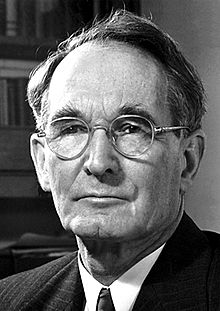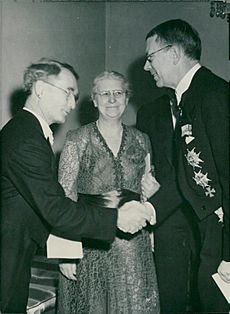Percy Williams Bridgman facts for kids
Quick facts for kids
Percy Williams Bridgman
|
|
|---|---|

Bridgman in 1946
|
|
| Born | April 21, 1882 Cambridge, Massachusetts, U.S.
|
| Died | August 20, 1961 (aged 79) Randolph, New Hampshire, U.S.
|
| Alma mater | Harvard University |
| Known for | High-pressure physics Operationalism Operational definition |
| Awards | Rumford Prize (1917) Elliott Cresson Medal (1932) Comstock Prize in Physics (1933) Nobel Prize in Physics (1946) Fellow of the Royal Society (1949) Bingham Medal (1951) |
| Scientific career | |
| Fields | Physics |
| Institutions | Harvard University |
| Doctoral advisor | Wallace Clement Sabine |
| Doctoral students | Francis Birch Gerald Holton John C. Slater Edwin C. Kemble |
Percy Williams Bridgman (born April 21, 1882 – died August 20, 1961) was an American physicist. He won the 1946 Nobel Prize in Physics for his amazing work with very high pressures. He also wrote a lot about how scientists should do their work. Some things named after him include the Bridgman effect, the Bridgman–Stockbarger technique, and a mineral called bridgmanite.
Contents
Life of Percy Bridgman
Growing Up and Family Life
Percy Bridgman was born in Cambridge, Massachusetts. He grew up in a nearby town called Auburndale. His parents were from New England. His father, Raymond Landon Bridgman, was a newspaper reporter. His mother, Mary Ann Maria Williams, was described as lively and competitive.
Percy was good at many things, including school, sports, and chess. He was a bit shy but also proud. His family enjoyed music, card games, and working in their garden. They were very religious, reading the Bible daily. However, Percy later became an atheist.
Education and Science Career
Bridgman started studying at Harvard University in 1900. He focused on physics and earned his PhD there. From 1910 until he retired, he taught physics at Harvard. He became a full professor in 1919.
In 1905, he began studying how different materials behave under high pressure. His equipment broke, which led him to invent a new and much better device. This new machine could create pressures over 100,000 times stronger than Earth's atmosphere. This was a huge step forward in science!
With his new tools, Bridgman made many important discoveries. He studied how over 100 different materials changed under high pressure. He looked at things like how much they could be squeezed, how well they conducted electricity and heat, and how strong they were. He also studied how electricity moves through metals and the properties of crystals.
Bridgman kept improving his high-pressure machines over the years. He even tried many times to create diamonds in his lab.
Ideas on Science
Bridgman also wrote a book called The Logic of Modern Physics (1927). In this book, he talked about "operationalism." This idea means that a scientific concept should be defined by the steps or operations used to measure it. He also helped organize international science meetings. He was one of 11 scientists who signed the Russell–Einstein Manifesto, which called for peace during the Cold War.
J. Robert Oppenheimer, who led the project to build the atomic bomb, was one of Bridgman's students. Oppenheimer said that Bridgman was a wonderful teacher because he always thought deeply about things.
Family and Hobbies

In 1912, Bridgman married Olive Ware. They were married for almost 50 years and had two children. They lived mostly in Cambridge, Massachusetts. They also had a summer home in Randolph, New Hampshire. There, Bridgman was known as a very good mountain climber.
Percy Bridgman was a very smart thinker and great with his hands. He was skilled at plumbing and carpentry and liked to do these jobs himself. He also loved music and played the piano. He was very proud of his flower and vegetable gardens.
Awards and Recognition
Percy Bridgman received many honors during his life. He was given honorary degrees from several universities, including Harvard, Princeton, and Yale.
He also won many important awards for his scientific work:
- The Rumford Prize (1919)
- The Elliott Cresson Medal (1932)
- The Gold Medal from Bakhuys Roozeboom Fund (1933)
- The Comstock Prize (1933)
- The Nobel Prize in Physics (1946)
- The Bingham Medal (1951)
Bridgman was a member of many important scientific groups, like the American Physical Society, where he was president in 1942. He was also a member of the Royal Society in London.
His home in Massachusetts, the Percy W. Bridgman House, was named a U.S. National Historic Landmark in 1975.
In 2014, a very important mineral was named after him: bridgmanite. This mineral is the most common one found deep inside Earth. It was named in his honor because of his pioneering research into high pressures.
See also
 In Spanish: Percy Williams Bridgman para niños
In Spanish: Percy Williams Bridgman para niños- Bridgmanite, a mineral named after him
- Pascalization, also called bridgmanization, a food preservation method
- Percy W. Bridgman House, his historic home
- Phases of ice, high-pressure forms of water discovered by Bridgman

